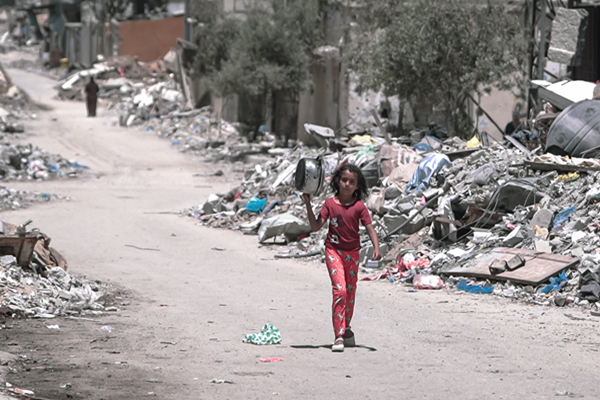.png)

Lt Gen Syed Ata Hasnain is a former Commander of India’s Kashmir Corps and Chancellor of the Central University of Kashmir.
July 29, 2025 at 7:08 AM IST
The Middle East, long described as the fulcrum of global geopolitical turbulence, currently finds itself in a deceptive lull. The decimation or substantial degradation of non-state militant actors such as Hamas in Gaza and Hezbollah in Lebanon, along with the diminished influence of the Assad regime in Syria, has seemingly brought a pause in the region’s perennial storm.
The arc of proxy warfare, once stretching from Tehran to the Mediterranean through Baghdad and Damascus, now appears fragmented. In Yemen, the Houthis remain the lone disruptive actor, threatening international maritime routes in the Red Sea and Arabian Sea, but without the cohesive regional momentum that once defined Iran-backed strategic ambitions.
Yet this apparent stabilisation is unlikely to be enduring. It may, in fact, be the eye of a larger, more catastrophic storm. The conditions for a resurgence of conflict are not only intact but also amplified by recent events — notably, the unprecedented violence and destruction unleashed upon Gaza by the Israeli Defense Forces in the aftermath of Hamas’s October 2023 attacks. The world has watched as Gaza was systematically battered, neighbourhoods levelled, and thousands of civilians killed. Whatever political or military objective Israel may have claimed, the images and narratives that emerged have seeded a legacy of rage, despair, and a deepened sense of victimhood among Palestinians and broader Arab and Muslim populations.
This virtual genocide, as it is increasingly termed in many quarters, could prove to be the crucible from which a new ideological and militant wave emerges. It is critical to understand that the Middle East is not a region where historical grievances quietly fade. Rather, it is a region where pain is generational and revenge is both cultural currency and political instrument. The Gaza war has not ended the Israeli-Palestinian conflict. It has merely transformed the terrain and the actors. With Hamas weakened militarily and politically, the emotional and ideological space is now open for the rise of a new formation — leaner, more radical, and potentially more transnational in its goals and methods
History provides a sobering precedent. The rise of ISIS did not occur in a vacuum. It was born out of the political marginalisation of Iraq’s Sunnis, the dismantling of Saddam Hussein’s Baathist apparatus, and the festering wounds of occupation. What emerged was not just a terrorist group but a quasi-state actor that redrew borders and upended the global understanding of asymmetric warfare. Today, similar ingredients are present across the region; disenfranchised youth, displaced families, disillusionment with traditional political structures, and a pervasive sense of abandonment by the international community. These conditions are fertile ground for radicalisation.
Moreover, the psychological impact of Gaza cannot be overstated. The scale and intensity of the destruction have had a seismic impact across the Arab world. While Arab governments may have adopted cautious or ambivalent postures, public sentiment has been dramatically inflamed. Demonstrations, social media campaigns, and underground support networks have all surged. There is now a significant gap between state policies — often dictated by realpolitik and foreign alliances — and the pulse of their populations. This dissonance creates a dangerous dynamic, where popular anger seeks outlets beyond the traditional political sphere. If suppressed or ignored, this energy will find expression in more clandestine and violent forms.
Another overlooked dimension is the transnational resonance of the Gaza war. Muslim communities across South Asia, Southeast Asia, and even the West have responded with anger and anguish. While these expressions may remain symbolic for now, history teaches that solidarity movements can evolve into logistical and operational support systems. The next militant formation may not be confined to Gaza or Lebanon or Syria. It could be a decentralised, hybrid entity drawing manpower, funds, and ideology from disparate corners of the world, united not by territorial control but by a shared narrative of resistance and vengeance.
It is also worth considering the shifting dynamics of state actors in the region. Iran, though facing internal challenges and economic sanctions, remains a potent ideological and logistical hub. Its proxy model has taken a hit, but Tehran is unlikely to retreat from its regional ambitions. Instead, it may recalibrate, empowering new actors or nurturing insurgent ideologies that are less visible but more lethal. Turkey, with its neo-Ottoman aspirations and growing regional assertiveness, could also become a sponsor or at least a catalyst for new Islamist movements, especially if these movements position themselves as defenders of Sunni identity against perceived Western-backed oppression.
Even among the Gulf States, which have recently invested in normalisation with Israel and economic diversification, the Gaza war has stirred deep internal debates. Governments may hold the line diplomatically, but they do so at the cost of growing domestic unease. This discomfort could translate into soft or covert support for resistance narratives, or at the very least, a retreat from security cooperation with Israel and the West. The Abraham Accords, once touted as a new era of peace, now appear strained and vulnerable. Peace built on transactional interests without addressing the core Palestinian grievance cannot sustain itself against the weight of such human catastrophe.
The West, particularly the United States and the European Union, bears partial responsibility for this impending cycle. Their unwavering support for Israel, even in the face of overwhelming evidence of disproportionate force and civilian casualties, has eroded whatever moral capital they retained in the region. Young Arabs no longer see Western democracies as arbiters of justice but as complicit in their suffering. This loss of legitimacy is more than symbolic; it undermines counterterrorism efforts, alienates potential reformists, and fuels the belief that only force can reclaim dignity and rights.
In this context, it is not far-fetched to envision the emergence of a new militant network — one that draws from the ruins of Gaza, the bitterness of Palestinian exile, and the ideological vacuum left by the decline of Hamas and Hezbollah. Unlike its predecessors, this entity may adopt a more amorphous structure, blending social activism, cyber warfare, and guerrilla tactics. It may also be less concerned with holding territory and more focused on symbolic and high-impact operations. Its targets may be regional or global, civilian or military, physical or digital. But its driving force will be clear: retribution and resistance.
The world was caught off guard not only by the brutality of ISIS but by the sophistication with which it wielded power — both on the ground and in the information domain. Its mastery of digital propaganda, recruitment, and psychological warfare enabled it to draw nearly 40,000 foreign fighters from across the globe, including thousands from the West. These were not merely the disaffected and marginalized but often educated, tech-savvy individuals driven by ideology and a sense of mission. The ability of such movements to combine zeal with operational coherence should never be underestimated. The next wave of radicalism may well learn from ISIS’s failures while retaining its strategic acumen — adaptive, decentralized, and capable of leveraging emerging technologies like AI, encrypted networks, and virtual currencies to wage ideological war across borders.
In this context, the prospects for the Abraham Accords advancing in the long term appear grim. Governments may still seek normalisation with Israel for economic or security reasons, but popular legitimacy for such moves has eroded sharply. The images from Gaza have reignited the pan-Arab and pan-Islamic consciousness in a way unseen since the early 2000s. The last time such a sentiment gripped the region; it led to the Arab Spring — a grassroots cry for dignity and justice that was ultimately betrayed by entrenched power structures. But history rarely repeats in the same form. If a second wave of mass mobilisation comes, it may be less about democratic reform and more about reclaiming lost honour through resistance. Whether this takes the shape of protest movements, new insurgencies, or ideological revolutions, the underlying truth remains: the region is seething, and beneath the surface of shattered cities and broken accords, something potent is already taking shape.
In conclusion, while the current geopolitical landscape in the Middle East may appear momentarily pacified, this calm is dangerously misleading. The emotional, ideological, and strategic aftershocks of the Gaza conflict are still unfolding. The region is not healing — it is incubating. And when the next wave comes, it may be more unpredictable, more lethal, and more widespread than anything seen before. The international community would do well not to mistake silence for peace, nor rubble for resolution. The seeds of the future have already been sown — in grief, in anger, and in the unforgiving soil of injustice.




